The key factor that promotes Vocational students development is the development of movement, which requires children to have excellent motor skills to develop their intellectual level, physical function and social adaptability in daily study and life. Data mining technology is an economical and practical core technology, which obtains useful information for the service system from a large amount of data. However, many teaching deficiencies in this area are prevalent in the field of early childhood education. In the current research on the content of Vocational students physical activities, a large amount of data information needs the support of data mining technology. This paper aims at how to combine data mining technology to study the content of Vocational students sports activities from the perspective of movement development, establish a decision support system for Vocational students sports activities, and conduct experiments on Vocational students sports activities from the perspective of action scientific arrangement and implementation of activity content, carry out empirical research on the content of Vocational students sports activities.
With the development of the Internet, digital education has gradually penetrated into the teaching process of different age groups. Early childhood education is the starting point and foundation of lifelong education in my country. However, scientific and reasonable physical education for young children is the most important component of early childhood education. Building a reasonable early childhood physical education content can effectively improve Vocational students physical quality and effectively cultivate children. There are a large number of relational databases in the education management system. Faced with such a huge amount of data, educators should analyze and apply it to find useful information [1]. To better promote the development of Vocational students sports activities.
Movement is the beginning of human cognition, and the research on movement development pays more attention to the infant stage. According to the difference of movements, it can be divided into gross movements and fine movements. With the gradual deepening of the level of research, basic motor skills can be divided into operational movements, displacement movements and non-displacement movements, including walking, running, jumping, climbing and other movements in the process of Vocational students movement development. The development of movements is of great help and practical value to the development of Vocational students movements. In my country, when studying the development of Vocational students movement, it is necessary to carry out a certain degree of movement intervention. According to research, Vocational students physical quality is directly proportional to movement development, and is inseparable from Vocational students emotional, cognitive and social development contact [2]. Therefore, it is very important to carry out research from the perspective of motor development in Vocational students sports activities.
Movement development is based on age stages and can be divided into the following Figure 1:

Place simple basic movements at the bottom of the triangle and more complex movements at the tip of the triangle. As can be seen from Figure 1, the movement development of children is based on the actions of the previous stage, and experience and preparation are particularly important. The learning of movements is to pave the way for the learning of complex movements. The basic movement stage is 2-7 years old. This stage focuses on the development of various basic movements. This stage includes 2-3 years old, 4-5 years old, and 6-7 years old, corresponding to the beginning, primary, and mature stages [3]. While the three stages are connected with each other, each also retains its own characteristics. At the beginning, young children try to make simple movements, such as kicking, catching, jumping, slapping, etc., showing an attempt with a plan and a goal. At this time, each repetition of the action can accumulate certain action experience for the development of complex actions in the future. The primary stage is a transitional stage. This stage is very important to the motor development level in adulthood. During this period, if there is no suitable environment to develop basic movements, it will result in a lack of motor ability in adulthood. The basic movements of the mature stage have been mastered and matured. It is manifested in the process of showing one’s own physique and integrating various motor skills into, accurate, proficient and suitable according to the task description. In general, the critical time for basic movement development at the age of 3-6. In this stage, the age of 3 is the most suitable time for children to learn movements. They are flexible and easy to remember the movements they learn. They like to imitate other people’s movements and repeat the same movements tirelessly. If they can be guided to a certain extent, Young children can gain experience with many motor skills. According to research, by the age of 5, all basic movements can appear [4].
The mutual restriction and traction of various factors lead to the development of action. From the perspective of social ecology, a constraint model is constructed, as shown in Figure 2.
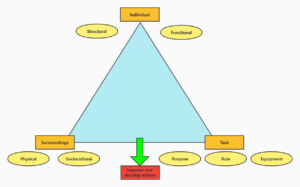
To illustrate the interaction of the individual, the external and internal environment, and the purpose of the movement on the development of the movement. This model emphasizes that to understand how individual actions change over time, it is necessary to take into account not only the originator of the action, but also the internal and external environment and purpose [5]. There is a dynamic interaction between the three main factors, and each characteristic of change may be affected by other ongoing changes. The model also emphasizes that the presence or absence of other individuals will affect the individual’s motor development, and factors such as the level of practice, lighting conditions, space, and the appropriate size and shape of equipment will also affect individual motor development.
Data mining technology involves a wide range of disciplines, such as statistics, databases, sociology, psychology and so on. The information stored in databases and data warehouses has a large number of random, fuzzy and incomplete characteristics, and data mining technology is the process of obtaining novel, effective, useful and understandable information from these information [6].
Data mining it is mainly composed of four steps: acquiring data source, extracting required information, data preprocessing, and implementing mining. A brief introduction to the steps is shown in Figure 3 [7].
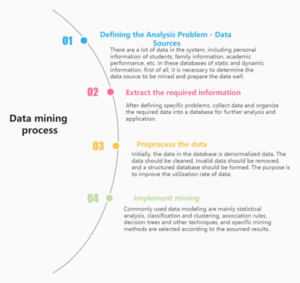
The specific process of data mining is shown in Figure 4.
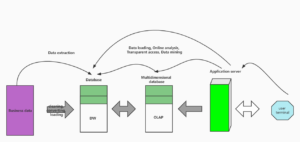
Association rule algorithm is the key of data mining technology [8], Apriori algorithm is a classic algorithm in association rule algorithm. Nowadays, when it comes to association rules, you can think of a variety of different classification bases. The most common one is to classify according to the dimension of the data type, and divide it into multi-attribute and single-dimensional. However, the type of data obtained is far more than three-dimensional, precisely because the research on the content of Vocational students physical activities will be affected by many factors. Therefore, multi-dimensional association rules need to be taken into account when designing decision support systems for Vocational students sports activities using data mining technology. In terms of the complexity of the content involved, multi-dimensional association rules are larger than single-dimensional association rules.
The data feature identification function of sports activity evaluation decision support system is:
In the design process of the decision-making system using data mining technology applied to the content of sports activities, it is necessary to construct an association rule to express the information of the data. In this paper, an adaptive weighting algorithm is used to construct a collection of sports content association criteria, and the final weighting coefficient of key rule mining is:
To sum up, this paper can realize the establishment of the system database model by mining the data of the sports content decision support system and extracting its association rules, and carry out the corresponding system design combined with the development of the software.
The decision support system for sports content is to simulate the effect of sports content carried out by young children by using computer-related language programming technology. It mainly solves the decision-making problems faced during the implementation of the activity content. The establishment of the decision-making system provides strong support for the establishment of rational and formal activity content for children, and then tracks and guides the effect of Vocational students physical activity content.
The frequent association rules of the Apriori algorithm are improved to design the human-computer interaction system, as shown in Figure 5. Its main functions include:
It not only provides a convenient design and planning environment for designers of Vocational students sports content, but also can input data such as Vocational students physical fitness and other data into the system, conduct simulations, and then conduct research and analysis according to the data returned by the system, and further use computers to carry out research and analysis. Track processing.
Feel the operation of the system more intuitively, obtain the first-hand information of the operation of the system, and make corresponding correct adjustments in the face of data changes.
According to the data returned by the system after human-computer interaction, the content of targeted Vocational students sports activities is adjusted, and the computer is used to arrange and combine the activities, so as to make the optimal arrangement.
It can automatically correct the wrong information, and conduct a preliminary “quality inspection” on the input data to see if it meets the requirements for continued operation.
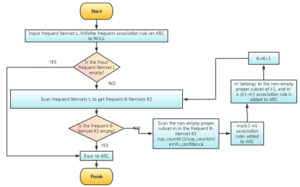
In order to verify the effectiveness of the improved Apriori algorithm, the traditional Apriori algorithm, the DC-Apriori algorithm and the mentioned improved Apriori algorithm are compared in this paper. The data used in the experiment is the data related to a certain physical activity of children, as shown in Table 1.
| Type | Bid | Ite | Avg |
|---|---|---|---|
| Data | 6512 | 225 | 48 |
In Table 1, Bid, Ite, and Avg are the specific types of activity content, the total number of projects, and the average number, respectively. With the increase of minimum support and minimum confidence, the change of system execution time is shown in Figure 6 and 7.
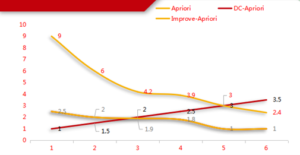
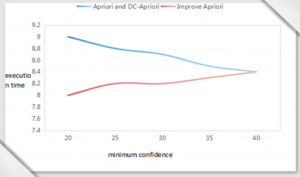
It can be seen from Figure 6 that the response time of the improved Apriori algorithm changes less in the case of minimum support, indicating that the improved algorithm is more excellent. As can be seen from Figure 7, when the minimum confidence is small, the improved Apriori algorithm is better than the previous algorithm, but with the gradual increase of the minimum confidence, the advantage of the Apriori algorithm is getting smaller and smaller until it reaches a flat effect.
In order to improve the regularity and rationality of Vocational students physical activity content, it is necessary to upgrade and innovate the decision-making system for physical activity content. A decision-making system for sports content evaluation based on improved Apriori algorithm is proposed. The deep mining and analysis of the data returned by the system can effectively filter and extract the information in the process of Vocational students activities, so as to improve the content of the activities. Secondly, through the simulated human-computer interaction experiment analysis of DC-Apriori, traditional Apriori algorithm and improved Apriori algorithm, it can be seen that the improved Apriori algorithm is more effective than the previous algorithm to realize the decision support of sports content, which is more effective for young children. Provide reasonable support for the design and arrangement of sports content.
Because the calcification of the bones of young children has not been fully formed, in the actual exercise process, young children will be easily fatigued and have poor endurance. It is most appropriate to control the exercise duration of young children to about half an hour [10], and this kind of fatigue in young children will disappear in a short time, which indicates that it is necessary to reserve enough time for children to exercise and rest. The heart development of young children is not perfect, the blood volume of the heart is smaller, and the heart rate is faster than that of adults, which indicates that the heart rate of young children during exercise should be maintained at the upper limit of the normal heart rate range [11]. In addition, most children use abdominal breathing when exercising, which requires children to avoid breath-holding sports in the actual exercise process.
The development of Vocational students cognitive ability mainly includes four aspects: memory, attention, imagination and thinking. Psychological research has shown that the reliability of concentration of four to five-year-old children is weak, and the concentration time does not exceed about ten minutes. Therefore, when young children engage in actual physical activities, they need to keep repeating the same actions and activities. The memory of young children also develops with age, and the use of mechanical memory mostly occurs in young children of this age. Therefore, when taking physical activities, do not overemphasize the normative nature of technical movements, but let young children carry out the movements. to follow suit and use this to develop their memory [12]. In addition, during this period, children have more logical thinking in play, and their ability to express logical thinking and language is poor, which is also an indispensable research direction. An important prerequisite for cultivating Vocational students creative ability is the development of imagination. Children will generate various whimsical ideas in participating in various game activities, and Vocational students movements can also be developed from this aspect.
In this study, the research objects were kindergarten students, and the children aged 3-4 were randomly divided into experimental class and control class. Among them, there are 19 boys and 21 girls in the experimental class, and 22 boys and 18 girls in the ordinary class. A six-month study was conducted with young children in two classes [13].
First of all, before the experiment starts, the hypothesis of the experiment should be done first, and the intervention should be determined. Secondly, to complete the experimental design, the first test is carried out, which includes observation and measurement of the basic movements of the children in the experimental group and the control group, including items such as balance beams. The third is the practice period, during which the experimental group needs to be intervened. At the beginning of learning, develop a practice plan on the results of the toddler’s test. Finally, there is the post-test phase, which is the second test within six months, and the test items are the same as the initial test.
In this study, a total of 160 cases of sports activities were selected, and relevant analysis and judgment were made. According to the results, in Vocational students sports activities, children aged 3-4 have 16 types of control actions. There are 2 types of non-controlling movements, and a total of 12 types of mobility movements. Children of different ages have different types of mobility movements. There are 21 types of children aged 4-6, and children aged 5-6. There are 23 kinds of Vocational students mobility movements, among which, in the activity practice of children aged 3-4 years, there are relatively few exercises, and some sports activities cannot be involved. The common contents of early childhood sports activities are shown in Table 2.
| Class | Action classification | Activity course content, sports game content, basic gymnastics content |
| Small class(3-4 years old) | Mobility action | Walk in all directions, listen to the signal to specify the direction to run, jump forward with both feet, walk on the balance beam |
| Small class(3-4 years old) | Control action | Throwing, catching objects, jumping with a ball, lifting, rolling, walking on slopes with objects |
| Small class(3-4 years old) | Uncontrolled action | Standing, standing with feet swapped |
| Middle class(4-5 years old) | Mobility action | Walking on tiptoe, walking half squat, walking sideways, walking over obstacles, dodge run, standing long jump, forward roll |
| Middle class(4-5 years old) | Control action | Stepping on balloons, jumping, balls, hula hoops, passing objects, skateboarding |
| Middle class(4-5 years old) | Uncontrolled action | arm wave |
| Big class(5-6 years old) | Mobility action | Double jump, chase run, shoulder throw, side drill, front drill, run-up straddle |
| Big class(5-6 years old) | Control action | Rolling tires, stepping on balloons, kicking a ball into a goal, flying a kite, playing baseball |
| Big class(5-6 years old) | Uncontrolled action | Arm wave, stand, stand with feet swapped |
Before the experiment, the movements mastered by both the experimental class and the control class included 10 types of mobility, 11 types of control, and 2 types of non-control, as shown in Table 3.
| class Action form | experimental class control class |
| Mobility action | Walk around, run, jump forward, walk with knees bent, drill, walk in a straight line, turn in circles, crawl on hands and knees, dodge, roll |
| Uncontrolled action | standing, feet swapped |
The experimental class was intervened. After the experiment, the movements mastered by the experimental class and the control children changed a lot, as shown in Table 4.
| class Action form | experimental class | control class |
| Mobility action |
Sliding, padding, different forms of variable-speed running,
high-leg running, stride running, escape, pony jump, cross-step, running and jumping, five-position starting |
Walk in all directions, listen to the signal to run in the designated
direction, jump with both feet and legs forward, open-leg jump, knee-knee, one-legged jump, drill, walk on the balance beam, turn in circles, crawl on hands and knees, dodge, climb, roll |
| Control action |
Playing balloons Various forms of elastic band exercises,
various forms of small cloth ball exercises, various forms of ladder exercises, four types of football exercises, swinging table tennis rackets, swinging badminton rackets, bag jumping, and various ways to play with sticks |
Throwing objects and squatting, picking up objects, walking
on slopes with objects, throwing, dragging, toe kicking, rolling tires, holding sticks, jumping with the ball, pushing the ball, walking with the ball, jumping with the ball |
| Uncontrolled action |
Center of gravity shift, arm waves, body waves, twisting,
jumping, landing |
Standing, standing with feet swapped, twisting and swinging
from side to side |
Physical fitness varies from person to person, and everyone’s physical fitness is different. All have their own characteristics. Even the same person’s physical fitness will change with the change of the environment and the increase of age [14]. Therefore, according to the physical quality of children at different ages, scientific and reasonable sports activities are arranged to continuously temper the physical quality of children. Physical qualities such as endurance, agility, rapidity, strength, and flexibility of the body do not exist and develop independently in daily activities and sports activities [15]. There is a constraint and promotion relationship between them, as shown in Figure 8.
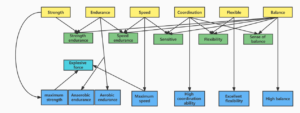
In the process of sports activities, only one physical quality is rarely involved, and generally two or more physical qualities are combined to exert their effectiveness [16]. For example, skipping rope, running back and forth, throwing tennis balls, etc., not only require strength, balance, speed, flexibility, but also coordination and agility. The explosive power of lower limbs in standing long jump is composed of speed and strength; the explosive power of upper limbs in tennis long throw is composed of speed and strength. The combination of these qualities has a high degree of flexibility. It is also necessary to follow the development law of Vocational students basic movements, follow the movements from simple to complex, and carry out different sports activities according to different age stages, so as to better meet the new requirements of Vocational students sports from the perspective of movement development [17].
For example, interventional teaching measures can be taken to stimulate Vocational students potential for motor development, allowing three to four-year-old children to participate in free batting skills practice, and some jumping sports content can be adopted at five to six years of age. The load intensity varies with the sports content, and it is necessary to understand the load intensity of the sports content thoroughly enough. Carrying out load training can enable children to better overcome the resistance existing in the outside world, and the resistance of objects can better develop their lower body strength. Since the actual motor development of different children is different, it is also possible to continuously strengthen the different training of children [18]. In general, the difficulty of a single action can be improved from the following elements: time, space, number of people, strength, route, direction, range, and combination of parts to complete the action, as shown in Figure9.

When children participate in various repetitive sports activities, most of them will feel boring and tired, which requires timely innovation and adjustment, whether it is for children to perform complex double-footed jumping, or for simple and boring one-legged standing, All need to be able to continuously design some interesting sports games according to the relevant sports actions according to the structure of the action, which can gradually enhance the interest of children in sports [19]. For example, when training young children on the balance beam, the height of the balance beam can be lowered for small class children, so that they can compare with whoever spends the least time on the balance beam, and then issue appropriate rewards to the winning children, which can better develop the Vocational students development. action level. When adding sports game teaching content, it is necessary to provide children with a better material and spiritual environment, which requires relevant kindergartens to go to the market to select and purchase some sports equipment suitable for children to use with educational funds, or they can use it when conditions permit. Under the circumstance of establishing a good physical activity venue, a physical activity classroom with classes as a group can also be arranged indoors. From the spiritual environment, it can provide children with more practice opportunities, guidance and encouragement and praise. Discover the true value of this physical activity [20].
Whether it is simple walking, standing, or complex jumping, running, or even more demanding sports activities. The completion of each complex movement is based on the basic movement, just like learning dance, starting from simple rhythm, walking, arm swing, step by step to the completion of a complex dance. In this experimental study, by using the transfer principle to design the activity process, the exercise form is selected by making full use of the movement tasks that are similar to the Vocational students existing movement experience in terms of movement structure, perception and change mode, as shown in Table 5.
| Project | Action structure | Perception | Way of change |
| Jump and standing long jump | Jump with feet off the ground | Accurate judgment of landing position | Variation of arm swing and take-off angle |
| Standing Long Jump and Continuous Jump | kick, take off, fly, land | Accurate determination of target location | Take-off strength, flying height, landing form |
| Standing long jump and straddling jump | feet off the ground | Accurate judgment of obstacle distance | take-off leg action |
We found that young Vocational students best practice experiences occurred when the movement components were most closely related to environmental conditions. At the same time, the movement practice must be based on the developmental level of the child.
Nowadays, most of the teachers in kindergartens are promoted by normal colleges, or composed of junior college students such as higher vocational colleges. Most of the courses offered in their majors are painting, rhythm, handicraft, dance, etc. Of course, they also include courses for Vocational students mental health training. However, there are few courses about computers, and some schools do not offer computer-related courses at all. In contrast, the application ability of emerging technologies is lacking, so that today’s kindergarten teachers lack data processing ability. In today’s era of big data, the requirements for this technical capability are even more indispensable. The group of teachers is the most frequent and most direct contact with children in the developmental stage, which puts forward higher requirements on the information literacy ability of kindergarten teachers. Innovation and adjustment of educational methods.
The amount of information stored in kindergartens is huge, involves a wide range of levels and is relatively scattered, and there is a lack of technical personnel for data mining in kindergartens, so it is impossible to form a complete database to store information for easy query and use. The development of young children is rapid, and the change of relevant information is also uncertain. Even the invariant information in the public impression still has a probability of change that cannot be ignored. Establish a data mining model, start from small problems to solve, build a complete database step by step, and then store the data information in a structured manner. Even in the face of constantly updated data, you can quickly update and find the content you want.
In order to achieve the purpose of making the content of Vocational students sports activities more formal, systematic and reasonable in line with the development of age stages. Establishing a decision support system for the content of Vocational students sports activities can practically plan the content of Vocational students sports activities. At this stage, my country’s key development areas include data mining technology, which has been immersed in all levels of various industries and plays a pivotal role. The analysis of sports content based on data mining technology can provide a corresponding decision-making system and better improve the arrangement of traditional Vocational students sports content. In the current sports scientific research, data mining technology has an irreplaceable role. With the development of information technology, it is inevitable and unstoppable to apply data mining technology to the field of Vocational students physical education. Technology is increasingly influencing the way education is done. Carrying out Vocational students sports activities from the perspective of motor development can enable relevant kindergartens and relevant teachers to provide more abundant training materials for Vocational students physical education teaching content, make sports facilities of various types, and also formulate for children more suitable for them.
The authors would like to show sincere thanks to those techniques who have contributed to this research.
All authors reviewed the results, approved the final version of the manuscript and agreed to publish it.
The experimental data used to support the findings of this study are available from the corresponding author upon request.
The authors declared that they have no conflicts of interest regarding this work.
This work was supported by Phased research results of the 2022 Jiangsu University Philosophy and Social Science Research Project—Research on the Effectiveness Strategies of Physical Exercise for Community Residents in Jiangsu Province under the Background of Normalized Epidemic Prevention and Control, No.: 2022SJYB1961.
1970-2025 CP (Manitoba, Canada) unless otherwise stated.